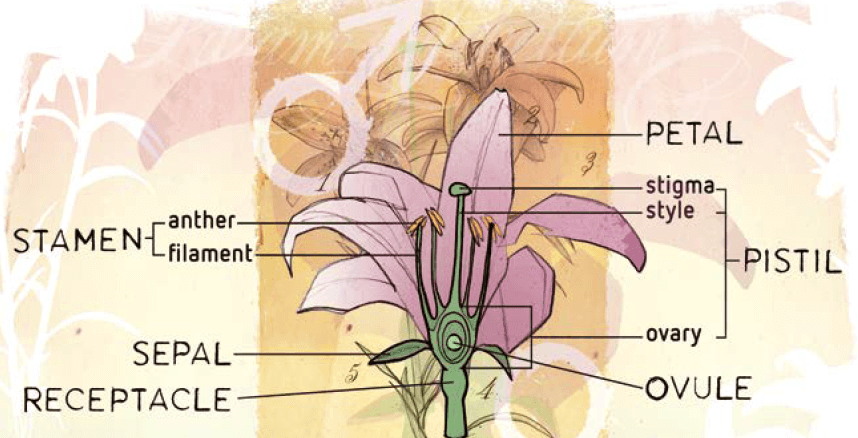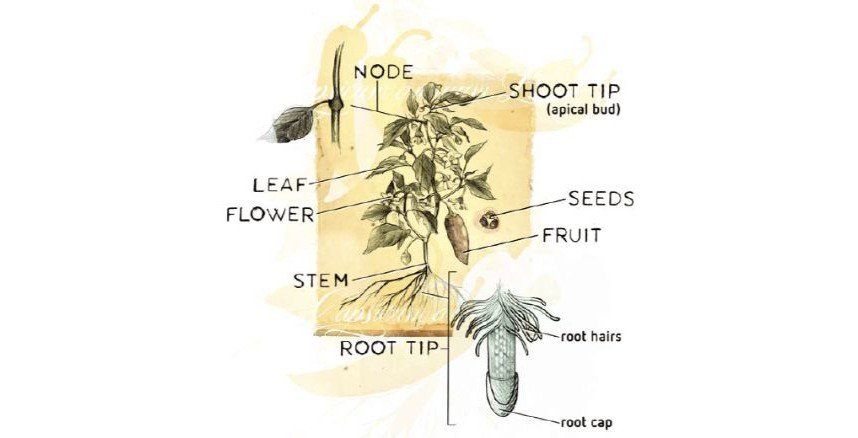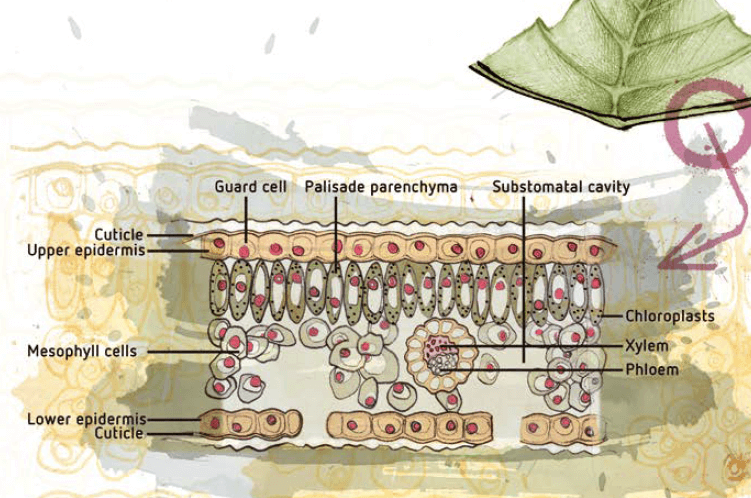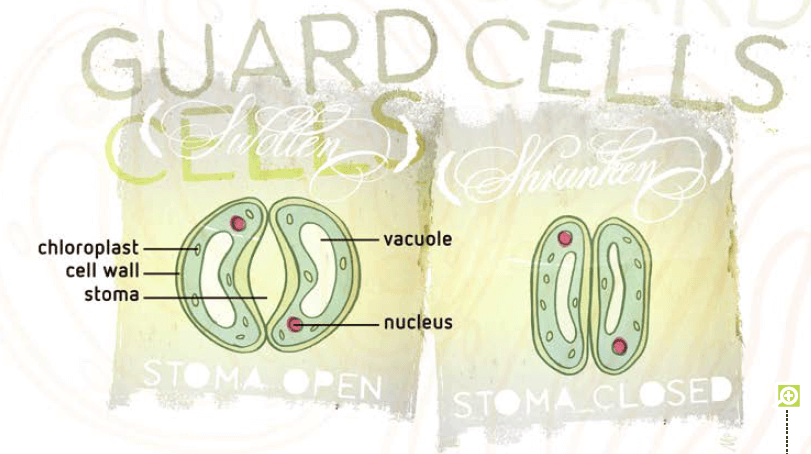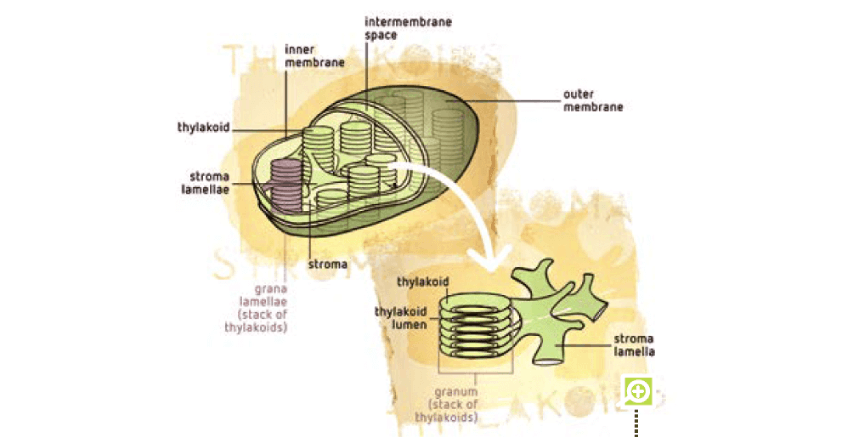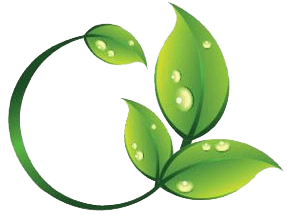The Basic Structure of Plants
Evolution and Reproduction
There is an enormous variety of flower types. But all flowers in essence contain the plants’ reproductive organs. The example above contains both male (stamen) and female structures (pistil), but these may also be separated into two flowers on the same plant or even on separate male and female plants.
Unlike animals, plants cannot run away from environmental stresses that may cause tissue damage. Nor are they able to escape from the numerous pests and diseases that can afflict them such as viruses, fungi and insects. But does this mean that plants are helpless? Of course not… after all, earth is known as the ‘green planet’ and many plant species are able to co-exist with their natural enemies and even in the most hostile places on earth.
Throughout evolution, plants have developed numerous traits to cope with these environmental stresses. They have done this in two main ways: by adapting the plant basic structure, and by producing chemical compounds - which are often species-specific.
In this article we try to describe some of the most commonly occurring forms of plant stress that you may or may not have already seen and the physiological disorders the plant may suffer from. And last but not least, we will look at some of the ‘tricks’ that plants have learned to cope with stress.
Now what is ‘environmental stress’ about? It usually includes all the non-living environmental factors that can
negatively affect the growth and productivity of plants. A lot of scientific research has been done on drought stress, the effects of flooding or submergence, salinity stress and extreme temperatures (both high and low). But for growers, well known issues such as high light intensity and deficiencies in inorganic nutrients (such as nitrogen, phosphorus, potassium) are included. The main reason for this is the key role of this type of stress in reducing yields in agricultural or industrial crops worldwide.
The basics of plant structure
To understand the issues described further on in this article it is important to understand the basics of plant structure. Possibly the most remarkable difference between plants and animals is plants’ ability to use sunlight as a direct energy source to produce all the chemical compounds needed to grow, survive and reproduce. It is no wonder, then, that the
basic structure of plants has evolved to facilitate this energy factory.
Below the ground…
In general a typical plant has a section below the ground and a section above the ground. Under the soil we find the roots, of course. Their basic functions include anchoring the plant firmly in the soil and taking up water and nutrients. Water-soluble nutrients are transported to the rest of the plant above ground via the stem to any location where the nutrients are needed: the leaves, the shoot tips, or the flowers and fruits.
The process of taking up nutrients involves a number of steps. The first requirement is that the nutrients themselves can move through the soil or substrate in the rhizosphere so that they can find their way to the roots. Then the nutrients need to pass several ‘root barriers’ – namely the cell walls, and then the cell membranes. Once inside the plant, the nutrients need to be transported through the plant’s vascular tissue (called the xylem), followed by cell-to-cell transport.
The biggest barrier is usually the cell membrane, which is highly selective. The basic structure of a cell membrane is the phospholipid bilayer, which has very low permeability for most nutrients. Carbon dioxide, oxygen, water and some neutral molecules like urea are the only products that can pass easily through the lipid layer of the membrane by diffusion.
All other essential mineral nutrients are absorbed as ions (with the exception of boron). This means that all nutrients (except boron) need membrane transporters. These are transport proteins embedded in the cell membrane which control the intracellular environment (the spaces between the plant cells).
Above the ground…
The section of the plant above the ground includes the stems, leaves, reproductive organs (flowers, fruits) and shoot tips, which contains as yet undifferentiated plant cells waiting for specific specialization (later they will become a leaf or stem tissue). After the roots take up the water and nutrients, there are several pathways for nutrient transport within the plant. The most common route is by ‘long-distance transport’ via the xylem vessels to the leaves and flowers (or any other plant organs). Two driving forces play a key role in this long-distance transport: the water potential gradient and the root pressure. Root pressure occurs when osmosis drives water from the soil into the roots. This is effectively because plants accumulate the nutrients taken up in the xylem tissue.
As we will see later in this article, various types of environmental stress can seriously affect this neat transportation system. For most plants (except for parasitic plants, which do not use sunlight as an energy source) one of the most vital organs are the leaves with the chloroplasts that contain the cells that the plant needs to photosynthesise. This includes everything needed to convert solar energy into bond energy and fix this into sugars. The chloroplast contains an extensive system of internal membranes, which are called thylakoids. The actual chlorophyll is located within this membrane system.
Most chloroplasts can be found in the mesophyll tissue of the leaves. Chloroplasts are thin-walled, metabolically active cells that are not only vital for photosynthesis, but also for the storage of sugar. The leaf mesophyll tissue is surrounded by intercellular spaces, spaces that contain air and are in contact with the atmosphere. Plants can regulate air exchange using their stomata - specialist cells that can open and close, actively closing the leaf off from the atmosphere at times. Close contact with air is required because photosynthesis requires the uptake of carbon dioxide and the release of oxygen. A cross-section of a typical leaf shows the location of these cell types.
It is worth having a closer look at the stomata. These cells not only play a crucial role in photosynthesis, but they also allow the plant to increase or reduce the rate of evaporation. Stomata are specialist cells on the lower side of the leaf. They typically consist of two cells that can vary in water content.
These cells are called the guard cells. The amount of water in the cell determines whether the stoma is in the open or closed position. The guard cells of a closed stoma contain relatively little water and appear to be shrunken and shrivelled. The cell walls of each of the two guard cells make contact over the full length of the cells.
To open the stoma, the plant has to increase the water level in the guard cells. The driving force behind this flow of water is osmosis: the plant actively increases the potassium level in the guard cells. As a response to the increasing potassium content, water starts to flow into the cells, causing them to swell. The contact between the two guard cells is reduced so that only the cell wall at the top and bottom of the cells are touching, leaving a
space - the stomata is now open.
By precisely controlling the water content in the guard cells, a plant can determine whether most of the stomata should be closed (no contact between the internal plant parts and the external atmosphere) or open (maximum plant-air contact). As we will see, this process plays a crucial role in plant stress responses, particularly in relation to water and drought stress.
In order for a plant species to survive over generations, flowering is a crucial process for reproductive success. While photosynthesis provides energy for the plant throughout its whole life cycle, the transition from a vegetative to generative stage marks a dramatic change in the plant’s energy investment.
This transition is characterised by the induction and development of the meristem of the inflorescence, which produce flowers (or one flower, where only one is produced) (see figure 1). This change contains both endogenous and exogenous elements; for example, in order for the change to begin, the plant must have a certain number of leaves and have reached a certain total biomass. Certain environmental conditions may also be needed, such as a characteristic photoperiod. This is most often the transition to long or short days. Even an internal ‘genetic’ trigger or circadian clock in the plant may cause the plant to flower. Plant hormones play an important part in the process, with the gibberellins having a particularly important role.
Article shared from our partners at Canna UK
Store Links
We will get back to you as soon as possible
Please try again later
Follow Us
Quick Links
Contact Information
Follow Us
Opening Hours
Monday-Friday: 10AM-5PM
© Emporium Hydroponics 2022. All Rights Reserved.

